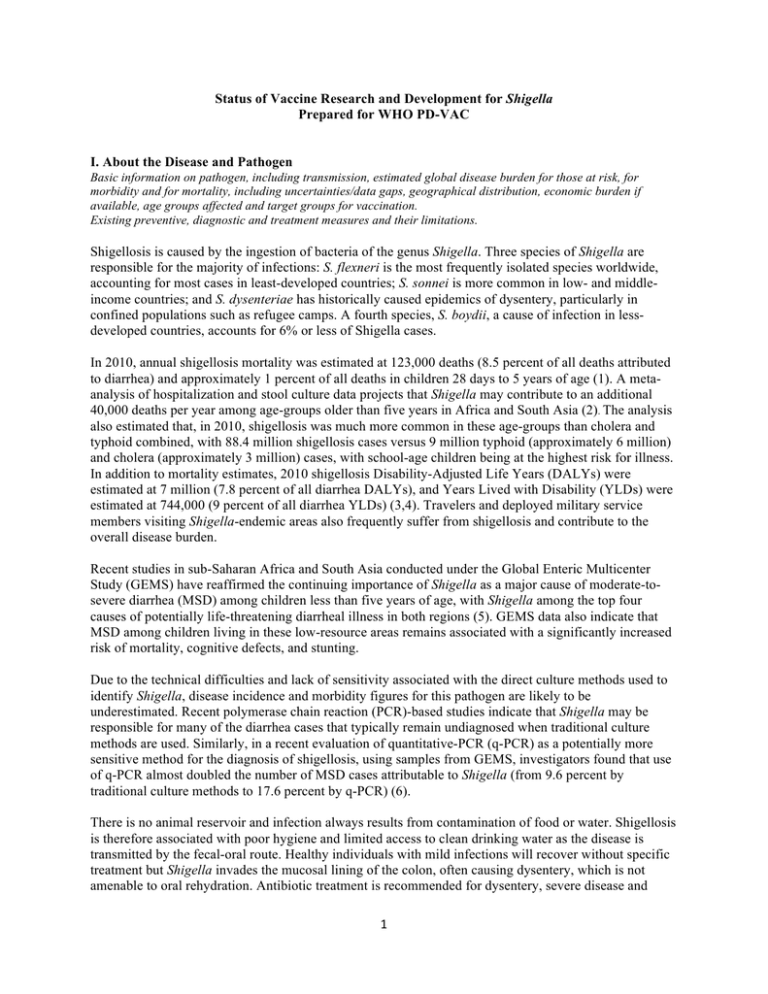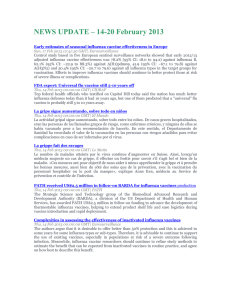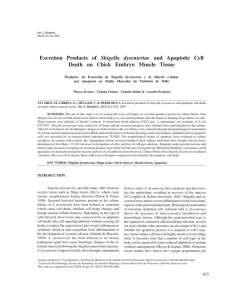1 Status of Vaccine Research and Development for Shigella
Anuncio

Status of Vaccine Research and Development for Shigella Prepared for WHO PD-VAC I. About the Disease and Pathogen Basic information on pathogen, including transmission, estimated global disease burden for those at risk, for morbidity and for mortality, including uncertainties/data gaps, geographical distribution, economic burden if available, age groups affected and target groups for vaccination. Existing preventive, diagnostic and treatment measures and their limitations. Shigellosis is caused by the ingestion of bacteria of the genus Shigella. Three species of Shigella are responsible for the majority of infections: S. flexneri is the most frequently isolated species worldwide, accounting for most cases in least-developed countries; S. sonnei is more common in low- and middleincome countries; and S. dysenteriae has historically caused epidemics of dysentery, particularly in confined populations such as refugee camps. A fourth species, S. boydii, a cause of infection in lessdeveloped countries, accounts for 6% or less of Shigella cases. In 2010, annual shigellosis mortality was estimated at 123,000 deaths (8.5 percent of all deaths attributed to diarrhea) and approximately 1 percent of all deaths in children 28 days to 5 years of age (1). A metaanalysis of hospitalization and stool culture data projects that Shigella may contribute to an additional 40,000 deaths per year among age-groups older than five years in Africa and South Asia (2). The analysis also estimated that, in 2010, shigellosis was much more common in these age-groups than cholera and typhoid combined, with 88.4 million shigellosis cases versus 9 million typhoid (approximately 6 million) and cholera (approximately 3 million) cases, with school-age children being at the highest risk for illness. In addition to mortality estimates, 2010 shigellosis Disability-Adjusted Life Years (DALYs) were estimated at 7 million (7.8 percent of all diarrhea DALYs), and Years Lived with Disability (YLDs) were estimated at 744,000 (9 percent of all diarrhea YLDs) (3,4). Travelers and deployed military service members visiting Shigella-endemic areas also frequently suffer from shigellosis and contribute to the overall disease burden. Recent studies in sub-Saharan Africa and South Asia conducted under the Global Enteric Multicenter Study (GEMS) have reaffirmed the continuing importance of Shigella as a major cause of moderate-tosevere diarrhea (MSD) among children less than five years of age, with Shigella among the top four causes of potentially life-threatening diarrheal illness in both regions (5). GEMS data also indicate that MSD among children living in these low-resource areas remains associated with a significantly increased risk of mortality, cognitive defects, and stunting. Due to the technical difficulties and lack of sensitivity associated with the direct culture methods used to identify Shigella, disease incidence and morbidity figures for this pathogen are likely to be underestimated. Recent polymerase chain reaction (PCR)-based studies indicate that Shigella may be responsible for many of the diarrhea cases that typically remain undiagnosed when traditional culture methods are used. Similarly, in a recent evaluation of quantitative-PCR (q-PCR) as a potentially more sensitive method for the diagnosis of shigellosis, using samples from GEMS, investigators found that use of q-PCR almost doubled the number of MSD cases attributable to Shigella (from 9.6 percent by traditional culture methods to 17.6 percent by q-PCR) (6). There is no animal reservoir and infection always results from contamination of food or water. Shigellosis is therefore associated with poor hygiene and limited access to clean drinking water as the disease is transmitted by the fecal-oral route. Healthy individuals with mild infections will recover without specific treatment but Shigella invades the mucosal lining of the colon, often causing dysentery, which is not amenable to oral rehydration. Antibiotic treatment is recommended for dysentery, severe disease and 1 individuals with compromised immune systems. However, the emergence of multi-drug resistant strains of Shigella further complicates treatment, making prevention of infection critical. II. Overview of Current Efforts A. Biological feasibility for vaccine development Evidence that vaccine development is biologically feasible including from development of naturally acquired immunity, from vaccine development for related pathogens, from animal models or in vitro data Any successful diarrheal disease control strategy against Shigella needs to employ all effective prevention and treatment interventions, including vaccines, improved sanitation/hygiene, and breastfeeding to help ensure long-term success and maximum impact. However, in more short-term cost-benefit analyses, many public health stakeholders view vaccination as one of the most equitable and cost-effective preventive interventions since more people can receive the benefit for every dollar invested. Unfortunately, there are currently no licensed vaccines available for Shigella, but human challenge study results and a sharp decline in agent-specific attack rates with increasing age indicate that solid protective immunity does develop. Studies also indicate that protective immunity is directed against the O-specific polysaccharide (O-SP) antigen of the Shigella cell wall lipopolysaccharide (LPS), and is type-specific. Furthermore, animal studies with experimental vaccines have shown that immune protection against Shigella infection is possible. B. General approaches to vaccine development for low- and middle-income markets What are the scientific approaches and indications and target/age/geographic groups being pursued? What public health needs will these vaccines meet if successfully developed? Where there are several different possible indications/target groups, how much consensus is there as to prioritization between these for vaccine development in LMIC Most Shigella vaccine candidates include the O-SP antigen, whether in a cellular or subunit format. The use of this antigen associated with cell wall lipopolysaccharide (LPS) is based on the observation mentioned previously, that immunity is serotype specific. Although the 4 Shigella species are divided into more than 47 serotypes, only certain types are considered to be important causal agents of human Shigellosis. Since S. dysenteriae, associated in the past with epidemic outbreaks, is now rare, a Shigella vaccine targeting protective antigens from these types, including the O-SP of S. flexneri 2a, 3a, and 6, as well as S. sonnei should cover a large majority of Shigella infections. Mucosal immunity is required for optimal protection, so most experimental vaccines, with the exception of conjugates, have been given by the mucosal route. An effective Shigella vaccine will largely benefit children living in developing countries, and as a result is perceived to have less market appeal to manufacturers who target the travelers’ market. III. Technical and Regulatory Assessment Highlight perceived positive/negative aspects in clinical/regulatory pathways e.g. well established product development and regulatory pathway to licensure, accepted immune correlates and/or functional assays, accepted surrogate efficacy endpoints, existence of well accepted animal or challenge models, agreed trial designs and endpoints. Possibilities to develop case for correlates/surrogates should be included. There are no established correlates of protection or functional assays for predicting Shigella vaccine effectiveness. There are a number of animal models to assess the potential of vaccine candidates, and human challenge models are established. Like with other enteric pathogens such as Salmonella and Campylobacter, Shigella infections has been associated with reactive arthritis or post-infectious arthritis, but this is not expected to be an issue with vaccines, which do not persist in the body for long periods. The probable endpoint for assessing vaccine efficacy will be moderate to severe diarrhea due to Shigella. 2 IV. Status of Vaccine R&D Activities Summarize status of vaccine design, pre-clinical and clinical trial activity, including platforms, vectors, and adjuvants. Note academic, government, biotech and industry entities engaged. Summarize antigenic targets (if subunit approaches). Section on major advances in last 3-5 years, including key opportunities highlighted by recent science developments in the area. Shigella vaccine research to date has been primarily focused on serotype-specific O-SPs, although some preclinical work has also evaluated protein antigens that could be more broadly conserved and also contribute to protection. As noted above, using serotype-specific immunity for protection, an optimal Shigella vaccine would include S. flexneri 2a, 3a, and possibly 6, as well as S. sonnei. This reduction in the total number of serotypes to these four for inclusion in a vaccine is based on the recent GEMS findings (5). Table 1 provides a summary of the development status of current Shigella vaccine candidates. Most research on the delivery of these antigens has involved live attenuated cells given orally, which have now been developed by selective genetic manipulations to be relatively safe and immunogenic. The two current approaches are a VirG-based mutant under development by the Walter Reed Army Institute for Research (WRAIR) and a GuaBA-based mutant under development at the Center for Vaccine Development, University of Maryland, Baltimore (UMB). In contrast to earlier mutations of wild-type shigellae, these new constructs have mutations that limit their ability to spread between epithelial cells (VirG) or replication of the bacterium (GuaBA), as well as deletion mutations for the sen and set genes associated with Shigella enterotoxin. The inclusion of msbB deletions to reduce the pyrogenic potential of the LPS of the bacteria is also being evaluated with the VirG attenuation strategy. These newer attenuated Shigella vaccine candidates induce robust immune responses and have a safety profile superior to those seen with previous constructs. A trivalent formalin-killed whole cell vaccine being developed by PATH and WRAIR and containing S. flexneri 2a and 3a as well as S. sonnei may further improve safety and ease of formulation. This vaccine candidate is in early clinical development and has been protective in animals. An S. flexneri 2a prototype for the trivalent vaccine was also safe and immunogenic in a Phase 1 trial. Another oral vaccine approach under development by Protein Potential, LLC is the use of the Ty21a vaccine for typhoid as a vector for Shigella LPS. This approach produced inconsistent results in earlier studies completed before the availability of modern genetic techniques, but recent genetic improvements in stability may offer better results in future trials. There has also been some research conducted on subcellular approaches. The National Institutes of Health’s National Institute of Child Health and Human Development (NICHHD) Laboratory of Developmental and Molecular Immunology (LDMI) proposed the concept of Shigella O-SP-protein conjugate vaccines for intramuscular injection. Since purified O-SP is poorly immunogenic, NICHHD/LDMI covalently coupled O-SP purified from Shigella LPS to protein carriers in order to induce stronger and longer-lasting T cell-dependent immune responses. Although some formulations using this approach have undergone Phase 3 trials, work has continued to develop a final formulation. In addition, during the last decade, a research group at the Institut Pasteur developed a glycoconjugate vaccine consisting of synthetically produced S. flexneri 2a oligosaccharide “mimics” conjugated to protein carriers (i.e., neoglycopeptides). Finally, a recombinant glycoconjugate candidate currently in clinical trials is being developed by GlycoVaxyn. The conjugates offer a safe approach and produce systemic immunity upon intra muscular administration. Whether the benefits reported with conjugates are due to boosting previous mucosal exposure or to initiation of an IgG response remains to be determined. Recent findings that mutants of labile toxin of enterotoxigenic Escherichia coli (ETEC) can be administered parenterally with a vaccine antigen and induce a mucosal and systemic response may 3 improve the potential for using the conjugate approach in young children. Novartis Vaccines Institute for Global Health (NVGH) is developing outer membrane vesicles of Shigella, termed Generalized Modules for Membrane Antigens (GMMA), as vaccines. NVGH has described an industrially scalable, high-yielding manufacturing process for GMMA using tangential flow filtration for purification and micro-filtration for sterilization. Three intranasal immunizations using GMMA derived from S. sonnei without O-SP/LipidA protected against either S. sonnei or S. flexneri in the intranasal challenge model, but only GMMA with homologous LPS were protective by the intradermal route. These are now in early clinical trials. In addition, the University of Navarra in Spain is developing acellular Shigella vaccine candidates based on outer membrane vesicles (OMVs) that are naturally secreted into the bacterial culture medium during the stationary phase of growth of wild-type strains. OMVs are 40 percent LPS, and they contain major outer membrane protein antigens such as OmpA, OmpC/OmpF, IpaB, IpaC, and IpaD. Preclinical studies showed that OMVs protected mice from intranasal challenge with homologous S. flexneri 2a after a single immunization by the intranasal, ocular, or oral routes. A team at WRAIR has continued development of second-generation TTSS-LPS complex vaccines by constituting artificial InvaplexAR from recombinant IpaB and IpaC purified by IMAC technology and LPS purified by standard hot-phenol extraction. This approach brings together important serotype-specific and conserved antigens of Shigella, and the artificial formulation may be more immunogenic than naturally produced Invaplex preparations studied earlier. Several protein-based vaccine candidates, in contrast to those above, may offer broad protection against all major serotypes, but have only been tested in animals. These include: the DB Fusion (being developed by PATH), consisting of a genetic fusion of the TTSS proteins IpaB and IpaD; Pan-Shigella Surface Protein 1 or PSSP1 (described by the International Vaccine Institute), which is shared by different Shigella serotypes and species; and a 34 kDa outer membrane protein (being developed by the National Institute of Cholera and Enteric Diseases, India). Each of these has provided some indication of protection in animal models. The DB Fusion may soon move to clinical trials where it will be co-administered intradermally with the double-mutant heat-labile toxin of ETEC, or dmLT, which is a powerful mucosal adjuvant and an ETEC antigen. Recent animal studies indicated that co-administering the dmLT with antigens intradermally or intramuscularly can induce both mucosal and systemic immunity. There are several excellent reviews that also describe the various approaches to Shigella vaccines currently under development (7, 8, 9). As described above, major advances in recent years indicate that there are some promising new approaches to Shigella vaccines in the works. These include attention to the broadly conserved surface proteins of Shigella, although these candidates are still in the early stages of development. The inactivated whole cell is another approach that has only recently been given serious attention. The trivalent candidate is yet to enter studies to show protection in humans, but it offers demonstrated safety and may be readily combined with another whole cell vaccine against another pathogen for a combined vaccine. Finally, the recombinant method of conjugate production by GlycoVaxyn is another promising advance in this approach to Shigella vaccines. Finally, the potential for using an adjuvant, such as the dmLT, raises new possibilities for using proteins or conjugate vaccines to induce mucosal responses from a parenteral injection, thereby widening the options for Shigella vaccine development. 4 Table 1: Development Status of Current Vaccine Candidates (POC = Proof-of-concept trial) Candidate Name/Identifier Preclinical Phase I Phase II POC Phase III Cellular candidates GuaBA-based live attenuated (CVD1208S) [UMB] VirG-based live attenuated (WRSS1, WRSs3, WRSf3) [WRAIR] Ty21a typhoid vaccine expressing Shigella LPS [Protein Potential] Inactivated trivalent Shigella whole cell [PATH] Glycoconjugate candidates Chemically prepared glycoconjugate [NICHHD/LDMI] Recombinant glycoconjugate [GlycoVaxyn] Synthetic glycoconjugate [Institut Pasteur] Novel antigen candidates InvaplexAR [WRAIR] GMMA [NVGH] OMV [University of Navarra] Subunit candidates DB Fusion [PATH] PSSP1 [International Vaccine Institute] 34kDa OMP [National Institute of Cholera and Enteric Diseases] X X X X X X X X X X X X X 5 References 1. Lozano R, Nagavi M, Foreman K, et al. Global and regional mortality from 235 causes of death for 20 age groups in 1990 and 2010: A systematic analysis for the Global Burden of Disease Study 2010. The Lancet. 2012;380(9859):2095-2128. 2. Lamberti LM, Bourgeois AL, Fischer-Walker CL, Black RE, Sack D. Estimating diarrheal illness and deaths attributable to Shigellae and enterotoxigenic Escherichia coli among older children, adolescents, and adults in South Asia and Africa. PLoS Neglected Tropical Diseases. 2014;8(2):e2705. 3. Murray CL, Lozano TR, Naghavi M, et al. Disability-adjusted life years (DALYs) for 291 diseases and injuries in 21 regions, 1990-2010: A systematic analysis for the Global Burden of Disease Study 2010. The Lancet. 2012;380(9859):2197-2223. 4. Vos T, Flaxman AD, Naghavi M, et al. Years lived with disability (YLDs) for 1160 sequelae of 289 diseases and injuries 1990-2101: A systematic analysis for the Global Burden of Disease Study 2010. The Lancet. 2012;380(9859):2163-2196. 5. Kotloff KL, Nataro JP, Blackwelder WC, et al. Burden and aetiology of diarrhoeal disease in infants and young children in developing countries (the Global Enteric Multicenter Study, GEMS): A prospective, case-control study. The Lancet. 2013;382(9888):209-222. 6. Lindsay B, Ochieng JB, Ikumapayi UN, et al. Quantitative PCR for detection of Shigella improves ascertainment of Shigella burden in children with moderate-to-severe diarrhea in lowincome countries. Journal of Clinical Microbiology. 2013;51(6):1740-1746. 7. Venkatesan MM, Ranallo RT. Live-attenuated Shigella vaccines. Expert Review of Vaccines. 2006;5(5):669-686. 8. Kaminski RW, Oaks EV. Inactivated and subunit vaccines to prevent shigellosis. Expert Review of Vaccines. 2009;8(12):1693-1704. 9. Camacho AI, Irache JM, Gamazo C. Recent progress towards development of a Shigella vaccine Expert Review of Vaccines. 2013;12(1):43-55. 6

